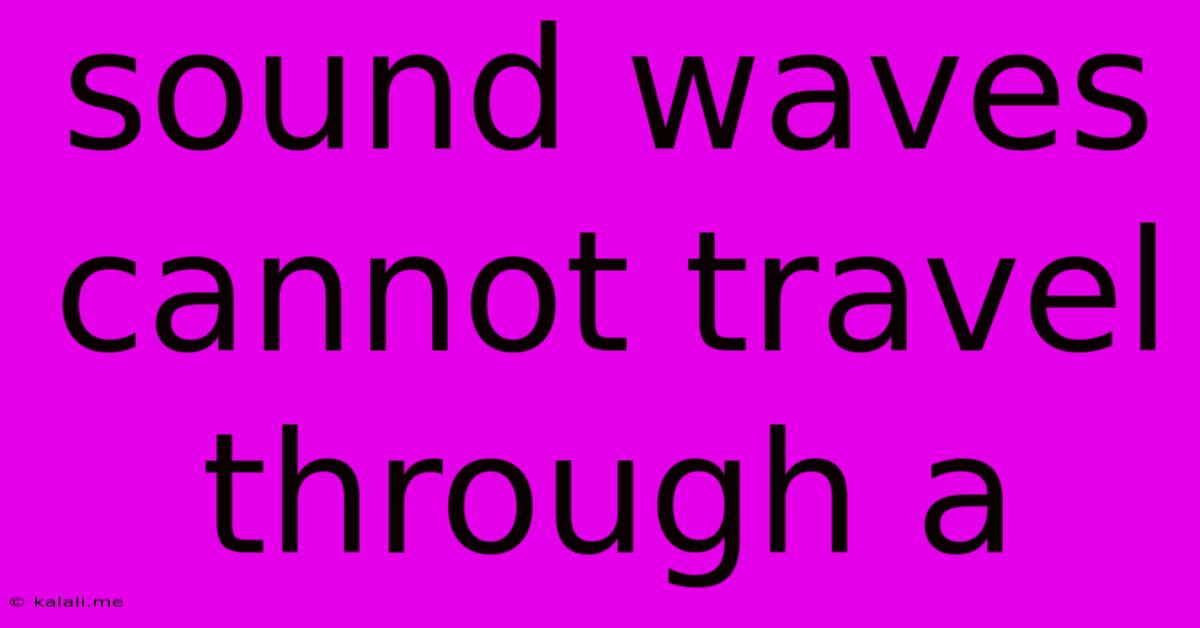Sound Waves Cannot Travel Through A
Kalali
Jun 15, 2025 · 3 min read

Table of Contents
Sound Waves Cannot Travel Through a Vacuum: Understanding the Science Behind Silence
Meta Description: Discover why sound waves need a medium to travel, and why you can't hear anything in the vacuum of space. This article explores the physics of sound propagation and explains the essential role of matter in transmitting sound waves.
Sound, the vibration that allows us to hear, is a fascinating phenomenon. But have you ever wondered why you can’t hear anything in space? The answer lies in understanding how sound waves actually travel. This article will delve into the science behind why sound waves cannot travel through a vacuum.
What are Sound Waves?
Sound waves are longitudinal waves, meaning that the particles of the medium through which the sound travels vibrate parallel to the direction of the wave's propagation. Think of a slinky being pushed and pulled – the coils move back and forth in the same direction as the wave itself. These vibrations create compressions (areas of high pressure) and rarefactions (areas of low pressure) that propagate outwards from the source of the sound.
The Crucial Role of a Medium
This is where the key to understanding why sound needs a medium lies. Those compressions and rarefactions need something to compress and rarefy! Sound waves require a medium to travel, such as air, water, or solids. The molecules within the medium are what transmit the energy of the sound wave. The molecules collide with each other, passing the vibration along.
Without a medium, there are no particles to collide and transfer the energy. The sound wave essentially has nothing to "push" against. This is why:
- Sound cannot travel through a vacuum. A vacuum, by definition, is a space completely devoid of matter. There are no atoms or molecules to transmit the vibrations. Hence, complete silence.
- Sound travels differently through different mediums. Sound travels faster in denser materials like solids than in less dense materials like gases. This is because the particles in denser materials are closer together, allowing for quicker energy transfer. Think about how much louder a train sounds when you're standing close to the tracks compared to being further away. The sound waves are travelling through air, but the closer you are, the more intense the vibrations reaching your ear.
Examples of Sound Wave Propagation in Different Media
Consider these examples to further solidify the concept:
- Air: Sound travels through air relatively slowly, approximately 343 meters per second at room temperature.
- Water: Sound travels much faster in water (around 1500 meters per second) due to the higher density and closer proximity of water molecules. This is why whales can communicate over vast distances underwater.
- Steel: Sound travels even faster in steel (approximately 6000 meters per second), demonstrating the effect of density on sound wave propagation speed.
The Silent Void of Space
The vast emptiness of space is a perfect vacuum. This is why astronauts need communication systems such as radios – which use electromagnetic waves (not sound waves) to transmit information – to communicate with each other and mission control. Sound waves simply cannot propagate through the vacuum of space.
In conclusion, the ability of sound waves to travel hinges entirely on the presence of a medium. Without particles to transmit the vibrations, the sound wave cannot propagate, resulting in silence. Understanding this fundamental principle illuminates the science behind the quietude of space and the diverse ways sound travels through different mediums on Earth.
Latest Posts
Latest Posts
-
What Type Of Slope Failure Is Shown In This Figure
Jun 15, 2025
-
Differentiate Between Short Run And Long Run
Jun 15, 2025
-
What Is The Difference Between An Entrepreneur And Entrepreneurship
Jun 15, 2025
-
Which Of The Following Is A Nonrenewable Energy
Jun 15, 2025
-
Is An Alloy A Heterogeneous Mixture
Jun 15, 2025
Related Post
Thank you for visiting our website which covers about Sound Waves Cannot Travel Through A . We hope the information provided has been useful to you. Feel free to contact us if you have any questions or need further assistance. See you next time and don't miss to bookmark.